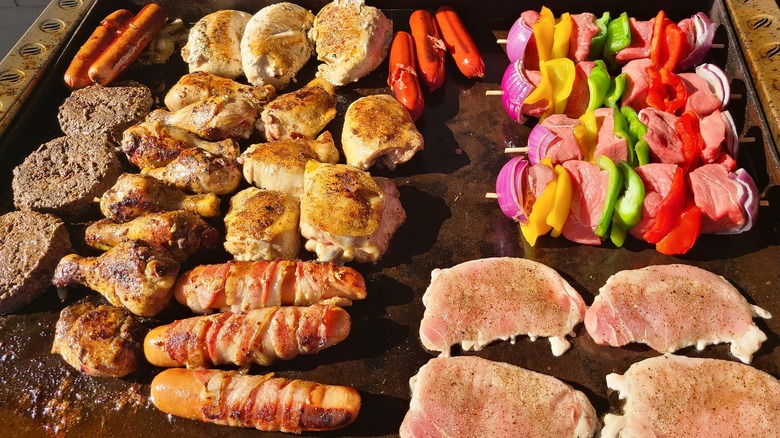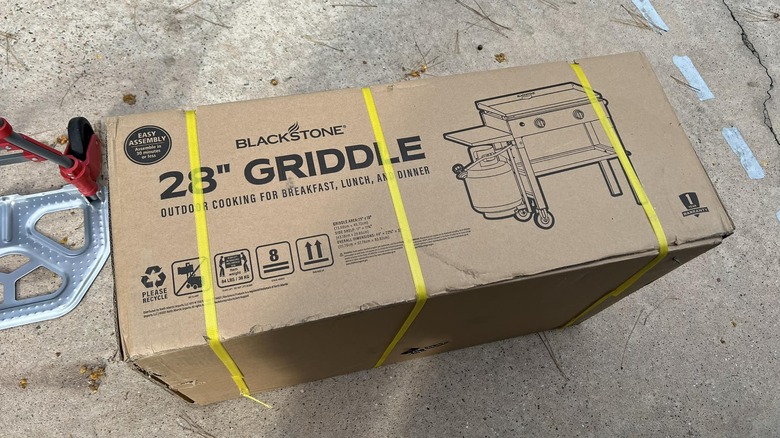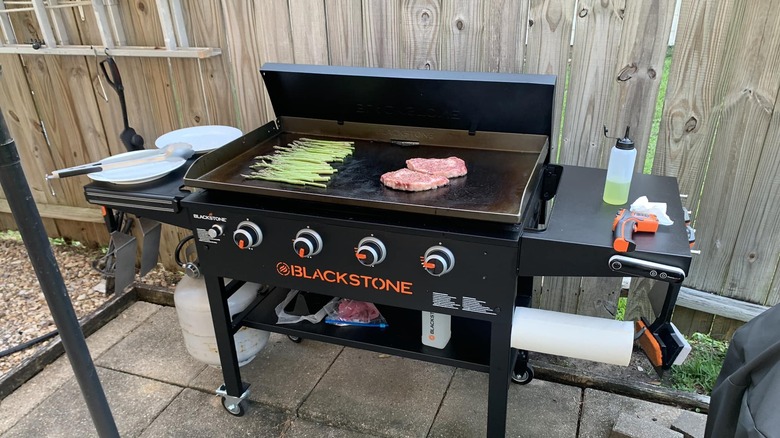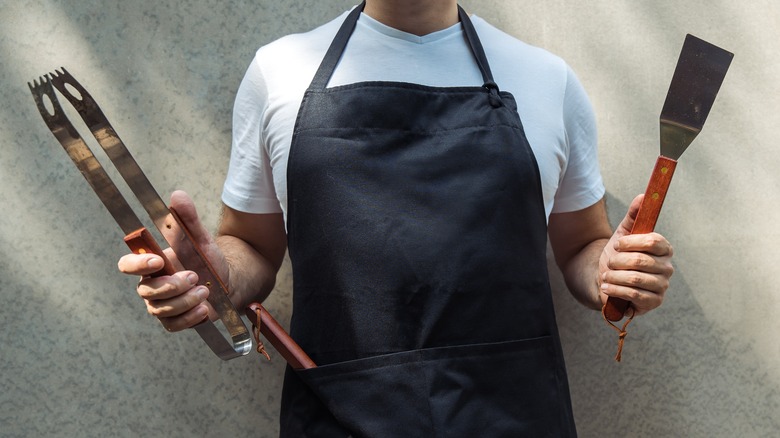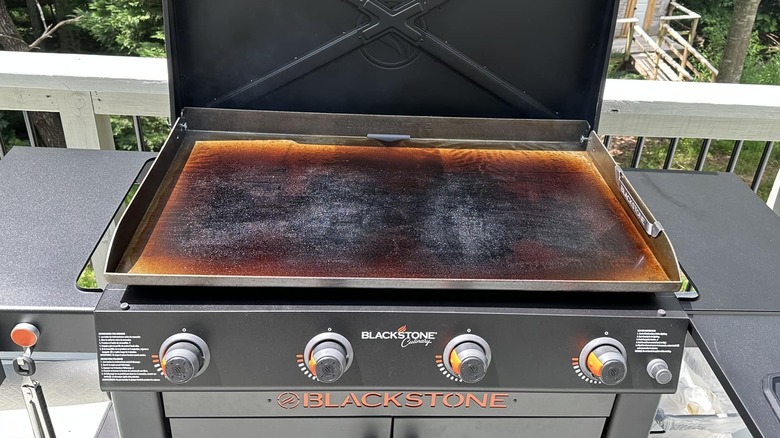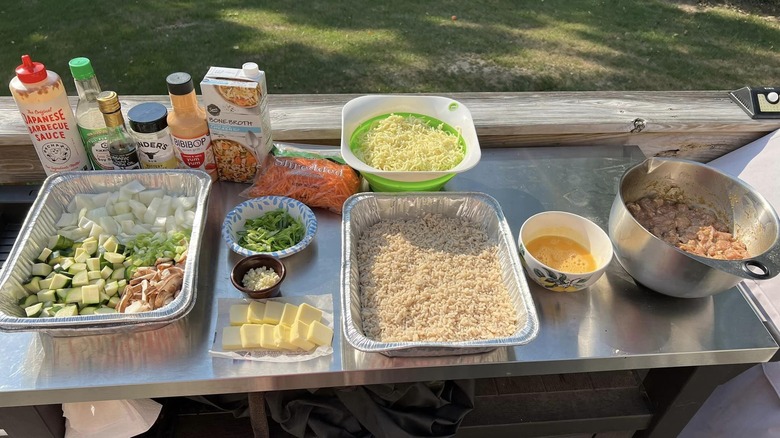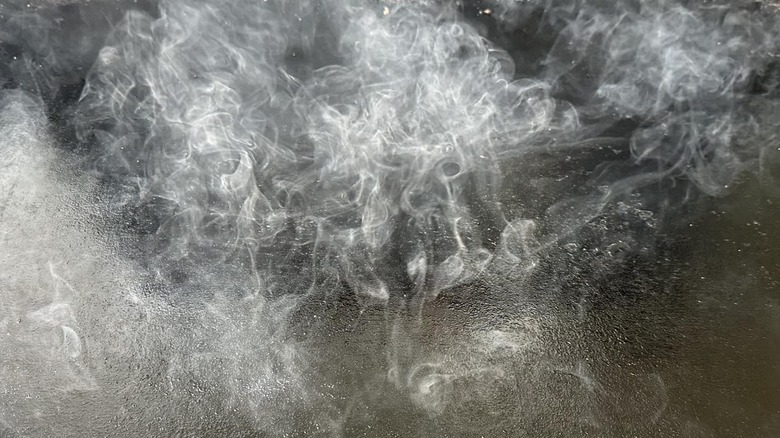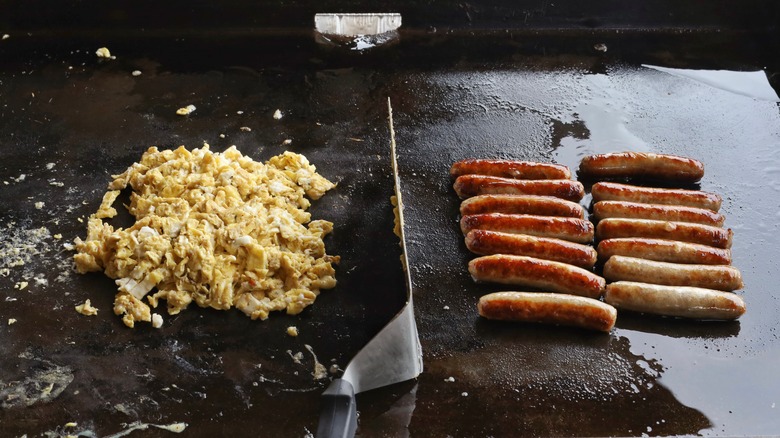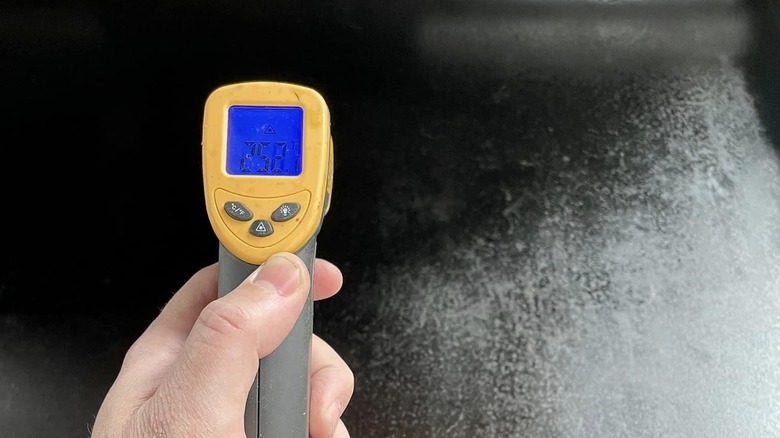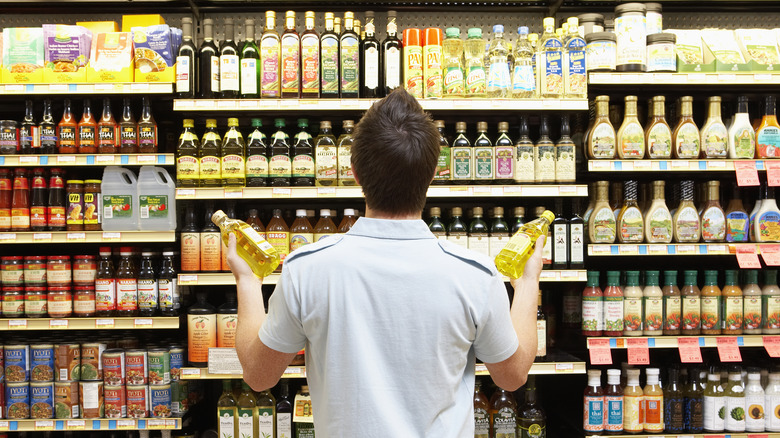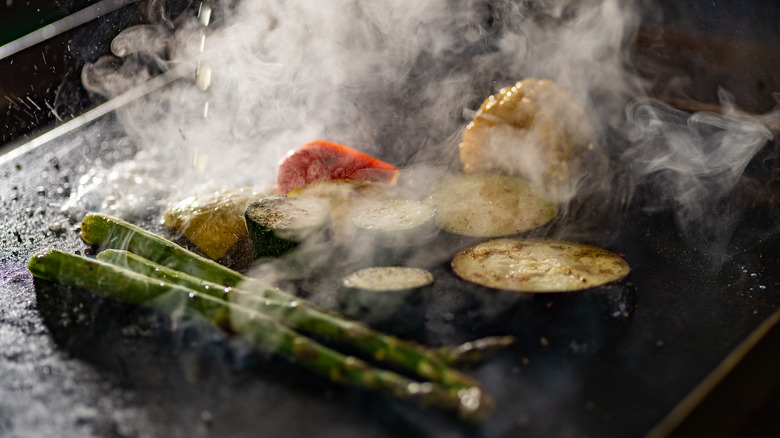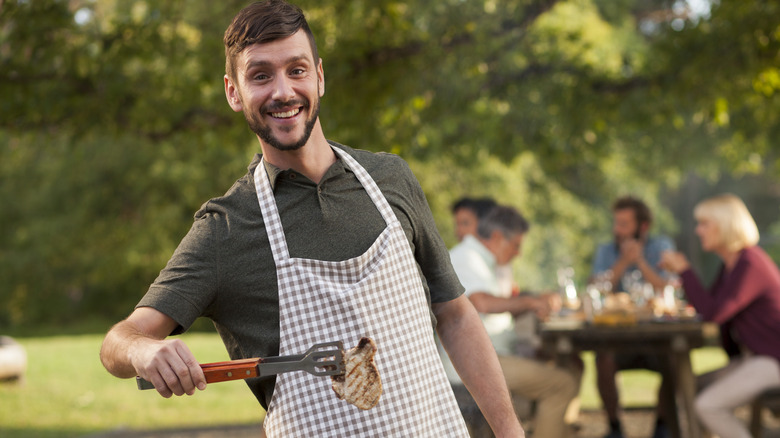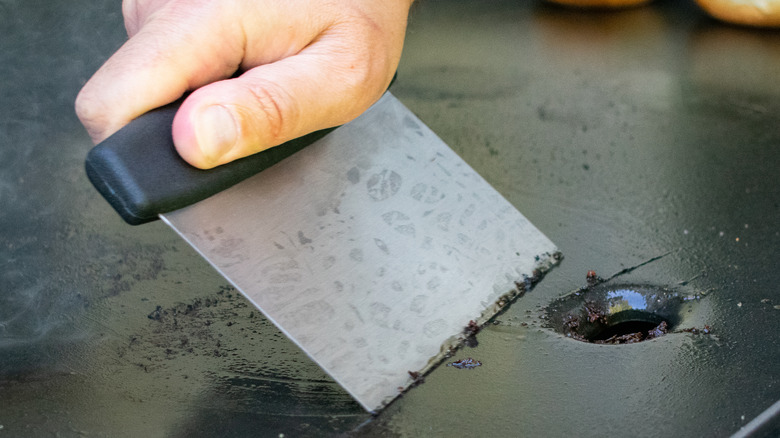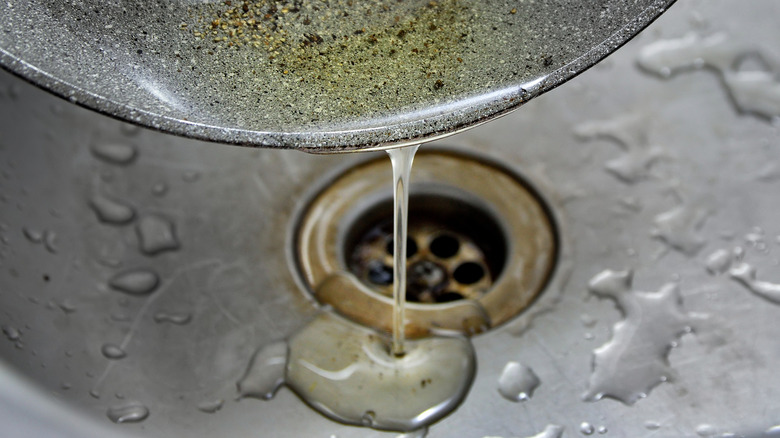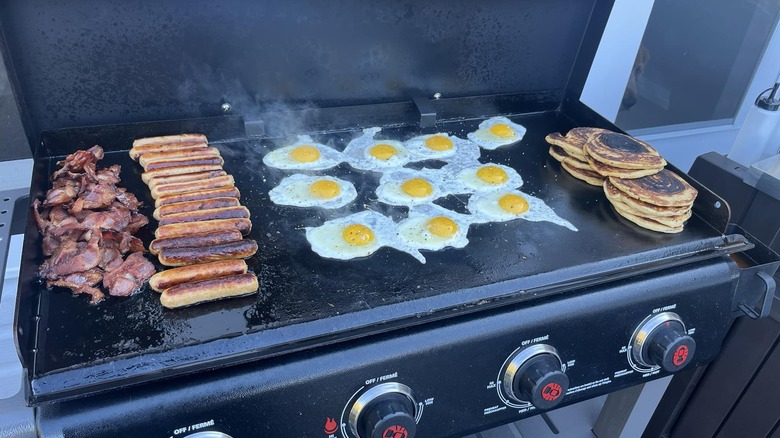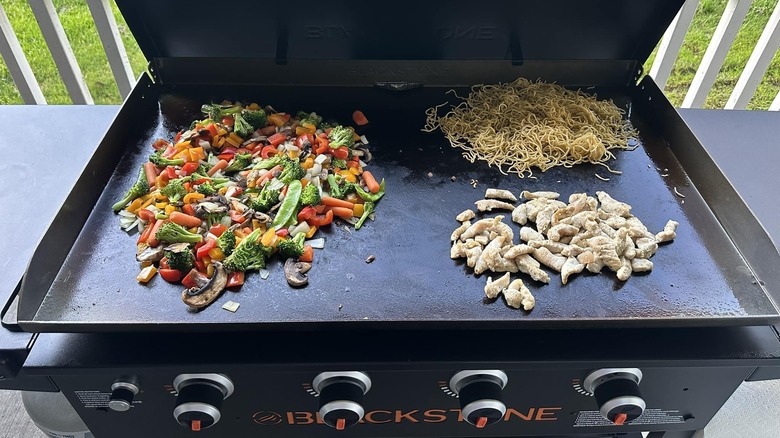15 Chef-Approved Tips You Need When Cooking On A Blackstone Griddle
When Blackstone launched its first 36-inch griddle back in 2008, it's unlikely anyone knew how much it would revolutionize outdoor cooking. Essentially a portable, gas-powered flat-top grill, Blackstone's extensive range has become a favorite of professional chefs and barbeque masters thanks to its versatility and the incredible food it produces.
I was trained on how to cook on a flat-top grill while working in restaurant kitchens, picking up tips and tricks from seasoned chefs. At home, when I finally made the switch from a grill-style barbeque to a Blackstone griddle, I found a lot of what I learned was transferable. Like the flat-tops in professional kitchens, the Blackstone griddle is incredible for speedy, high-heat cooking that gives users excellent temperature control and a sizable area for cooking larger quantities of food in one go. It can handle multiple ingredients simultaneously, with larger models even offering definitive cooking zones with varying heat levels. However, while Blackstone griddles can produce superb food, it's not as simple as turning up the heat and throwing on your ingredients. While my cooking experience certainly helped, mastering a Blackstone requires knowledge that's somewhat specific to the appliance. Below, I've compiled a list of the most useful tips you need for cooking on a Blackstone griddle, ranging from setting it up to cleaning it down, with must-know advice for getting the best results every time.
Don't rush the assembly process
Unless you're picking one up second-hand, the first step towards firing up your Blackstone griddle is piecing it together. Fortunately, the process is relatively straightforward and doesn't require any fancy tools — a Phillips head screwdriver and adjustable wrench should be sufficient.
That said, you'll want to pay close attention to the included instruction manual if you want to get the assembly right on the first try. Not only will the booklet contain details on how to set up your warranty, but also a highly detailed guide on how to put your new griddle together. If you've got a second-hand griddle without a manual, Blackstone has digital manuals for all of its models available for free download on its website. It's also recommended you have a partner to help with the assembly process. Depending on the size of your griddle, the cooking plate will likely be pretty heavy, so it helps to have someone else on hand to help you lift it into place.
Plan placement and storage
Before you fire up your Blackstone griddle, you'll need to think about where it's going to be stationed. Most folks use their griddle outside, and the first thing you'll want to consider is the type of surface it's going to be sitting on.
The priority is making sure the ground is even and stable, as you want to make sure there's no chance the appliance will tip at any point, potentially damaging the unit and causing injury to anyone nearby. You'll also want to make sure you have enough room to maneuver while cooking and that the griddle plate is as flat as possible. It's a good idea to use a spirit level to ensure the unit is evenly positioned. Where you store your Blackstone is up to you. Some folks prefer to move their griddle under cover to protect it from the elements, but this might not always be possible. If you need to keep your Blackstone outside, it's worth purchasing a cover to protect it from inclement weather that may cause rust to develop over time.
Invest in quality cooking utensils
One of the Blackstone griddle's biggest draws is its versatility, allowing you to cook all manner of delicious foods with it. That said, you'll be limited in your culinary creativity if you don't arm yourself with quality utensils and supplies.
Flat-top grills are commonplace in commercial kitchens, so this is a great place to look for inspiration. You'll want a good pair of tongs and a sturdy spatula for flipping, moving, and serving your food. Additionally, a griddle press, cloche, and a scoop are useful tools to have on hand. You also want to pick up a few squeezy bottles — cooking on a Blackstone tends to use a lot of oil, and these bottles are invaluable when it comes to controlling how much and where you apply it. Cleaning your griddle between uses is crucial, so you should invest in scrapers and wire brushes to make the task easier. You'll also want to keep a healthy quantity of heavy-duty paper towels in stock for wiping down the griddle plate, absorbing excess oil, and seasoning.
Don't skip seasoning
You've assembled your new Blackstone griddle and found the perfect place for it, but before you can get cooking, there's a critical step that can't be missed — seasoning. I'm not talking about salt and pepper here, however, but preparing the griddle plate for cooking.
Seasoning means binding a protective layer of oil to the cooking surface — much like you would a cast iron pan — to stop food from sticking, protect the griddle plate, and help with heat distribution. You'll need to repeat the process fairly often between uses, but fortunately, seasoning your Blackstone griddle is a relatively simple task. First, give the griddle a good clean, then use your paper towels to coat the plate with oil. Blackstone sells its own seasoning oil, but a high smoke-point oil like avocado or canola works just as well. Turn the heat up high until the oil starts to smoke, then give it another 10 minutes or so to burn off. You'll then want to repeat this process two or three times until the surface takes on a dark, even sheen, indicating it's ready for cooking.
Prep your food in advance
One of the advantages of cooking with a Blackstone griddle is that it produces a lot of heat, resulting in short cook times. However, this also means that once your first piece of food hits the griddle plate, you won't be left with much time to prep additional ingredients.
The key is to have as many of your ingredients prepped as possible before you start cooking. Dice, peel, and chop everything that needs to be diced, peeled, and chopped. If you're using seasonings, sauces, or oils, have them ready to go, because you don't want to be running back and forth to the kitchen to grab anything you've forgotten. Many Blackstone griddles come with shelving attachments, which can make it easy to line up your ingredients, but be careful: The residual heat from the griddle can get these shelves hot, so you may want to avoid putting items on them that may melt or cold ingredients that might start pre-cooking. Instead, you might find it easier to set up a small side table to lay out everything you need for cooking.
Preheat your griddle before cooking
In most cooking scenarios, you should let your appliance reach the required temperature before you add any food, and this is no different when you're using a Blackstone griddle. Luckily, they don't take particularly long to heat up, and turning the griddle on about 10-15 minutes before cooking should be enough time to get it ready.
The issue with cooking from cold is that it generally results in food that's cooked unevenly. Often, you'll find that the exterior of food will cook but the interior won't get the heat it needs, especially with thicker items like juicy steaks and burgers. You also run the risk of not giving any fat or oil enough time to render properly, leading to undercooked, greasy food. If you've prepped everything you need but forgot to warm up your griddle, don't be tempted to skip the preheating step, as that little bit of extra time will make all the difference.
Understand the cook zones
Depending on which Blackstone griddle model you own, there's a good chance it comes with multiple burners that sit beneath the griddle plate. Each burner will have its own temperature dial, which means you can adjust their heat separately to create different cooking zones.
Being able to create multiple heat zones is perfect for cooking multiple ingredients at once; for example, you might want to grill burger patties on one zone, fry up some bacon on another, and slow-cook onions on a separate section. However, determining the exact heat distribution of each zone requires a little bit of experimentation. If one zone is set to high heat, it will also increase the temperature of adjacent zones, so you'll need to be sure you don't inadvertently burn ingredients in neighboring areas. Once you become more familiar with where each zone is located and how they affect one another, you'll find it much easier to cook a wider variety of ingredients at once.
Pick up an infrared thermometer
While the dials on a Blackstone griddle give you a lot of control over how much heat each burner provides, most are labeled in a way that doesn't provide a precise temperature. This can pose an issue when you're preparing foods that require specific temperatures and you're trying to avoid undercooking or burning them.
Also, according to Blackstone, its griddles can heat up to over 650 degrees Fahrenheit. This is a temperature that most folks will never need for cooking, but if you accidentally get your griddle too hot, it can take some time for it to cool down again. The most effective way to determine the temperature of your griddle is by investing in an infrared thermometer. Simply point the thermometer at any section of the hot plate, and you'll be given an exact reading of the current temperature. This is also extremely handy in working out where your hot spots and cooking zones are. The downside of these thermometers is that while they're superb for determining surface temperature, they won't tell you whether food is fully cooked in the middle. For this, you'll want to pick up a high-tech food thermometer with trusted reviews.
Pick your oil carefully
If there's one thing you'll always have a need for if you own a Blackstone griddle, it's cooking oil. Aside from needing the oil to regularly season the griddle plate, you'll also be using it for most recipes — and you need to make sure you're using the right type for the job.
Cooking oils have something called a smoke point, which is the temperature at which they begin to break down, and it varies from oil to oil. If the oil gets too hot, aside from starting to smoke, it will start to impart a nasty, acrid taste into your food. There's also the chance it could get hot enough to catch alight, something you should avoid at all costs. The trick is to try and stick to oils with a high smoke point when you're cooking on high heat — avocado, sunflower, and canola oils tend to fall in this category. Olive oil is great for sautéing, but its lower smoke point means it's less suitable for anything above 375 degrees Fahrenheit.
Don't add oil too soon
Because Blackstone griddles tend to get hot quickly, you need to be particular about when you add your oil. Add it too soon, and it'll start to break down before your food has had a chance to cook. You'll end up with the same flavor issues that you get from oil that's past its smoke point.
The easiest option is to add the oil just before you add your food to the griddle, and using a squirt bottle tends to make this even easier. However, if you're still finding that it's heating up too soon, there's another route you can take. By coating your food in oil before throwing it on the griddle plate, they'll heat up at the same rate. This also has another advantage: If you're using dry herbs or spices for flavor, the oil will help them stick to the food, meaning you'll end up with tastier results. You also want to be wary of any excess oil left on the griddle after seasoning it, so make sure you give the surface a thorough wipe down with paper towels before you start cooking.
Minimize the mess
While cooking with a Blackstone griddle produces delicious food, it can be a little messy. There tends to be a decent amount of grease produced, which can also spit as it gets hot and ingredients are flipped and maneuvered around the hot plate.
To avoid ruining your clothes or, even worse, getting splashed with hot oil, think about donning a heavy-duty cooking apron. While a fabric apron will do the trick, you can also opt for an apron made with oil-proof rubber, which you can wipe clean between uses without having to throw it in with your regular laundry. With yourself taken care of, it's time to think about where your Blackstone is situated. If you want to avoid getting grease stains on your deck or patio, you may want to position it on top of a section of old carpet or a piece of tarp that you can wipe or spray clean. If, despite these measures, you find yourself needing to mop up a spill, you can use kitchen staples like salt or flour to absorb cooking oil, making it easier to clean up.
Clean your griddle as soon as possible after cooking
Cleaning a Blackstone is simpler than you might think, but under one condition — clean the griddle every time you cook on it, as soon as possible after you're finished. The longer you leave it, the harder it will be to remove excess grease and food remnants.
When you're done cooking, turn the griddle off and use a scraper to coax any remaining oil and food particles to the sides and into the grease tray. Given the griddle will still be hot, now's a good time to don a pair of heat-resistant gloves if you own a pair. The scraper should make short work of anything that's burned onto the surface, but for stubborn residue, squirt a little water onto the problem area, and it should release fairly easily. Next, use your paper towels to wipe the griddle plate clean. Now, whether you should season the griddle at this point depends on who you ask. Some folks say you should season after every cook, but this is likely excessive, so you may just want to re-reason when you notice the griddle is losing its non-stick properties. Whichever you choose, when you're done, add a very light coat of oil to the cooled griddle, as this will protect the surface from rust.
Dispose of grease properly
I've already mentioned that cooking on a Blackstone griddle tends to produce a lot of grease and that most models have a tray to catch the remnants. However, you need to think carefully about how to dispose of these leftovers.
Before you decide to throw it away, it's worth remembering that cooking oil is generally safe to reuse if you filter it and keep it refrigerated. If you don't want to go down this route, be aware that you should never dispose of used grease down the sink, as it can solidify and block your plumbing. One method is to carefully decant the used oil into a wide-mouthed jar or container, then throw it in the trash once it's cooled down. Alternatively, you can copy Martha Stewart's approach to disposing of cooking oil and use paper towels to absorb the leftovers. When the oil-soaked paper is cool enough to handle, simply scoop them up and put them in the trash.
Practice makes perfect
Unless you picked up your Blackstone on a whim, there's a good chance you were sold on the idea after seeing the potential of what they can do. However, while everyone can learn to be a griddle pro, if you're new to using one, don't expect to become a master overnight.
There are plenty of helpful guides online — hopefully, this one is included — but at the end of the day, it takes practice. You need to become intimately familiar with the nuances of your appliance by learning where its hot spots are and what temperatures work best for different foods. Be prepared to make mistakes, and when things go wrong, try to learn why, whether it was the timing, temperature, or amount of oil you used. If you keep messing up a particular type of food, don't be disheartened; research potential solutions and try again. Over time, you will get better. Also, when you do overcome a particular issue, try and share your advice online. There's a sizeable, welcoming community of Blackstone lovers and it thrives off shared experiences.
Don't be afraid to experiment
There are a number of classic recipes that have helped to earn Blackstone griddles their iconic reputation, such as homemade smash burgers or perfectly cooked, crispy bacon. However, while you'll certainly get great results with these dishes, it's worth stepping out of your comfort zone.
Blackstone griddles are insanely versatile and you might be surprised to discover what you can use them for. For instance, why not try whipping up our recipe for Hunan-style beef stir-fry, a dish whose delicious complexity belies its simplicity? If you've recently used your griddle for bacon, think about saving the grease and using it to revive leftover fried rice. With the right tools, you can use your Blackstone to make moreish nachos, homemade pizza, or even freshly "baked" cookies. At the end of the day, experimentation will yield untold outcomes, and while not every recipe will be a winner, you're guaranteed to land on some dishes that defy your expectations.

